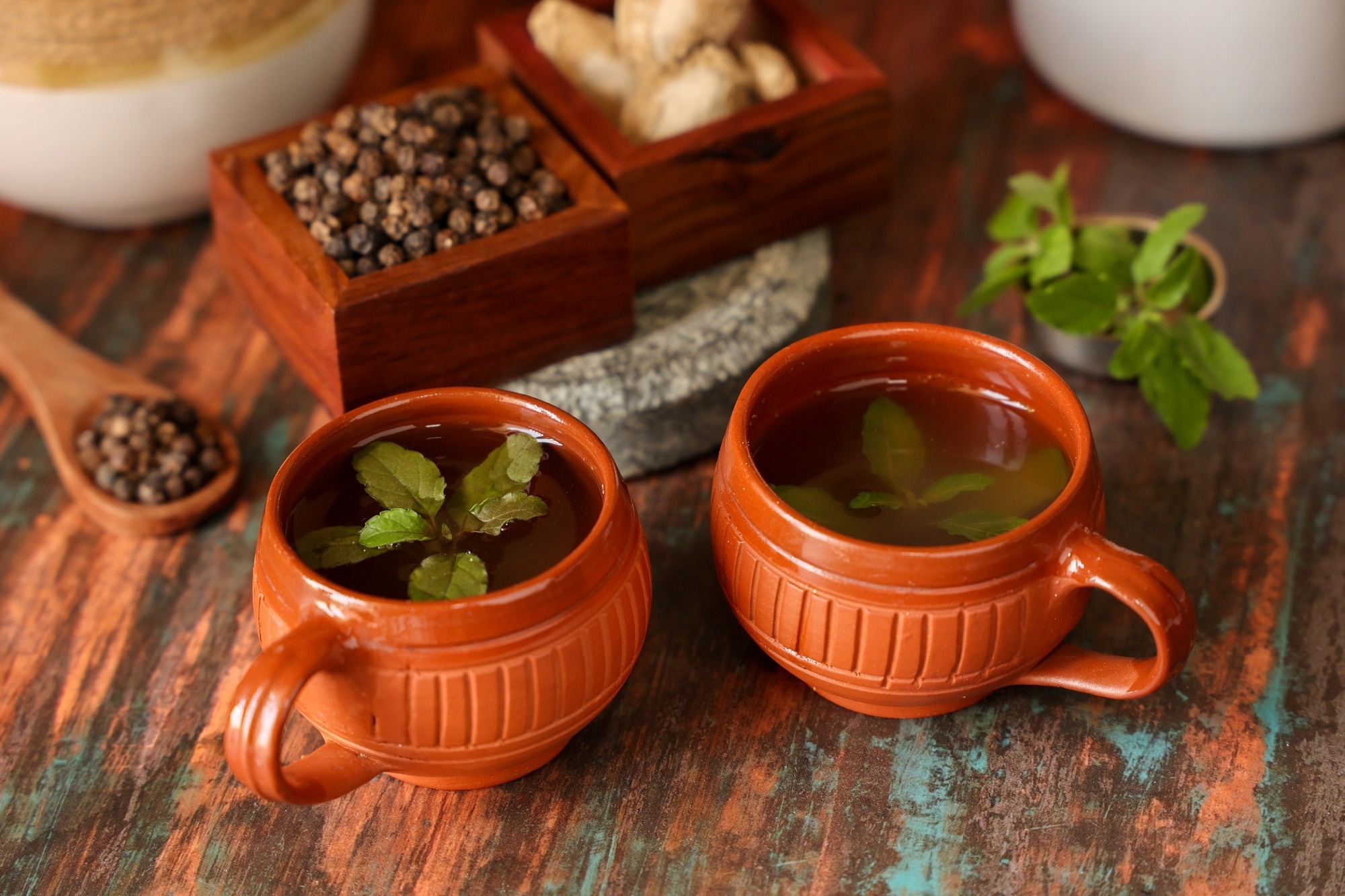Introduction
Botanical background
Traditional uses in medicine
Current scientific research
Safety and contraindications
Limitations of current research
Conclusions
References
Further Reading
From ancient Ayurvedic remedy to modern scientific spotlight, tulsi (holy basil) is emerging as a promising botanical for stress, metabolic health, immunity, and beyond—yet experts caution that robust clinical trials are still needed.
 Image Credit: Santhosh Varghese / Shutterstock.com
Image Credit: Santhosh Varghese / Shutterstock.com
Introduction
For over 3,000 years, tulsi, which is also known as holy basil, has been revered in Ayurveda as a sacred plant and remedy for ailments of the body and mind. Modern pharmacological research is now beginning to validate what ancient medical systems have long claimed about tulsi.
Ocimum sanctum, commonly known as tulsi or holy basil, is an important herb in Ayurveda and other Southeast Asian traditional medicine systems. For several centuries, tulsi has been venerated in many cultures for its spiritual symbolism, in addition to its wide-ranging medicinal properties.1
In recent decades, tulsi has garnered increasing scientific interest, particularly in the context of modern health challenges such as chronic inflammation, metabolic disorders, and psychological stress.1-4 This article critically examines the evidence behind tulsi’s health benefits through the lens of modern scientific research, including its adaptogenic, antimicrobial, anti-inflammatory, and metabolic effects.
Botanical background
Tulsi belongs to the family Lamiaceae and genus Ocimum. The most well-known species used medicinally is Ocimum sanctum, which is also known by the synonymous taxonomic name Ocimum gratissimum.5 The bioactive constituents of O. sanctum include eugenol, ursolic acid, rosmarinic acid, apigenin, and linalool, all of which are compounds known for their antioxidant, antimicrobial, and anti-inflammatory effects.2,3
Tulsi is commercially available in multiple forms, including fresh leaves, dried powders, teas, essential oils, and encapsulated extracts. The concentration of active compounds in these preparations varies.
Traditional uses in medicine
In Ayurveda, tulsi is believed to promote longevity, enhance resilience, and foster systemic balance. Traditionally, tulsi has been used as a household remedy to treat a wide range of ailments, including fever, cough, asthma, bronchitis, malaria, diarrhea, and skin diseases. It is often consumed as a tea, infused into oils, or in herbal powders and pastes.4
Tulsi is also considered an adaptogen that supports the body’s ability to acclimate to physical, emotional, and environmental stressors.1 In folk medicine, tulsi has been used to relieve headaches, earaches, and indigestion, whereas its leaves are applied topically for insect bites and skin eruptions.
Tulsi seeds and roots have been used traditionally for their diuretic and detoxifying properties.5 Across Southeast Asia, tulsi remains a staple in ethnomedicine, especially in a cultural context, for its perceived ability to purify the air and protect the household from illness and misfortune.6
Current scientific research
Adaptogenic and anti-stress effects
The adaptogenic effects of tulsi are among the most extensively studied. In a double-blind, placebo-controlled human trial, supplementation with an O. tenuiflorum extract (OciBest) significantly reduced symptoms of stress, including exhaustion, sleep disturbances, and forgetfulness, over six weeks.7 These effects could be attributed to compounds such as eugenol and ursolic acid present in tulsi, which modulate cortisol levels and neurotransmitter activity.1
Anti-inflammatory and antioxidant properties
Tulsi’s antioxidant properties are attributed to its ability to upregulate enzymes such as superoxide dismutase and catalase while scavenging free radicals.2 In fact, a 2014 study reported that tulsi leaf extracts reduced lipopolysaccharide-induced tumor necrosis factor α (TNF-α) secretion and nuclear factor kappa-light-chain-enhancer of activated B cells (NF-κB) translocation, both of which are key inflammatory processes, in human monocyte leukemia cell lines.8
Rosmarinic acid, eugenol, and other phenolic compounds have also been shown to modulate pro-inflammatory cytokines and inhibit cyclooxygenase (COX) enzymes, thus suggesting the potential utility of these compounds within tulsi to prevent chronic diseases associated with oxidative stress.4
Metabolic health
Several studies have also reported the effectiveness of tulsi in regulating blood glucose and lipid profiles. In clinical trials, tulsi supplementation has improved fasting blood sugar, HbA1c, and cholesterol levels in diabetic patients.3,6
The underlying mechanisms of these effects include enhancement of insulin secretion and improved lipid metabolism through modulation of key enzymes like 3-hydroxy-3-methylglutaryl coenzyme A (HMG-CoA) reductase and adenosine monophosphate (AMP)-activated protein kinase (AMPK).4
Antimicrobial and immunomodulatory activity
Tulsi exhibits broad-spectrum antimicrobial activity, including against bacteria such as Staphylococcus aureus and fungal species like Candida albicans. Eugenol and carvacrol are known to disrupt microbial cell membranes, while polyphenols interfere with biofilm formation and microbial adhesion.4,5
Immunologically, tulsi has been shown to enhance macrophage activity, natural killer (NK) cell function, and antibody production in preclinical studies. Human trials have also reported improved immune markers, including lymphocyte proliferation and cytokine balance, following tulsi supplementation.6
Cognitive and neurological benefits
Preclinical research has highlighted the neuroprotective properties of tulsi, particularly in models of cognitive impairment and neuroinflammation. The use of tulsi extracts has been shown to improve memory retention, decrease the rate of neurodegeneration, and reduce oxidative stress in animal models of Alzheimer’s disease, amnesia, and age-related dementia.3,5
Apigenin and rosmarinic acid in tulsi are also associated with anxiolytic and antidepressant properties through modulation of pathways linked to the neurotransmitters gamma-aminobutyric acid (GABA) and serotonin.1. These findings suggest the potential applications of tulsi extracts in adjunctive care for mood disorders and cognitive decline.
Other potential benefits
The therapeutic properties of tulsi and its extracts are being explored across the fields of dermatology and hepatic health. The antimicrobial and anti-inflammatory properties of tulsi make it a promising candidate for acne, eczema, and wound healing applications.2
Tulsi has also demonstrated hepatoprotective effects in chemically induced liver damage models by attenuating oxidative damage, enhancing antioxidant defenses, reducing lipid peroxidation, as well as improving liver enzyme profiles and histopathological markers.5
 Image Credit: Olga Apansenko / Shutterstock.com
Image Credit: Olga Apansenko / Shutterstock.com
Safety and contraindications
Human trials report minimal side effects associated with tulsi ingestion. However, tulsi may interact with anticoagulants, hypoglycemic agents, and sedatives due to the impact of this plant on metabolic and central nervous system (CNS) pathways.6
A recent animal model study reported lower sperm counts, reduced levels of follicle-stimulating hormone (FSH) and luteinizing hormone (LH), as well as increased levels of testosterone in male rabbits after supplementation with fresh tulsi leaves.9 Comparatively, other studies have reported no adverse effects of tulsi or its extracts on the reproductive health of male or female murine models.4
The use of tulsi during pregnancy and lactation has not been well studied. Thus, caution should be exercised while using this herb during pregnancy.
Limitations of current research
Most studies examining the health benefits of tulsi are preclinical or involve small sample sizes. Furthermore, few large-scale, randomized controlled trials with clearly defined endpoints and standardized preparations have been conducted to validate the clinical efficacy of tulsi.
Although tulsi is classified as a dietary supplement in the United States, it is not approved as a drug by the U.S. Food and Drug Administration (FDA) or European Medicines Agency (EMA).
Conclusions
From managing stress and inflammation to enhancing metabolic and immune health, tulsi shows promise as a complementary strategy in preventive and integrative medicine. Current evidence suggests that consumers and practitioners should use tulsi as a supportive, adjunctive herb, preferably under the guidance of qualified health professionals.
References
- Cohen M. M. (2014). Tulsi - Ocimum sanctum: A herb for all reasons. Journal of Ayurveda and Integrative Medicine, 5(4), 251–259. DOI: 10.4103/0975-9476.146554, https://pubmed.ncbi.nlm.nih.gov/25624701/
- Almatroodi, S. A., Alsahli, M. A., Almatroudi, A., & Rahmani, A. H. (2020). Ocimum sanctum: Role in Diseases Management Through Modulating Various Biological Activity. Pharmacognosy Journal, 12(5), 1198–1205. DOI: 10.5530/pj.2020.12.168, https://phcogj.com/article/1217
- Muszalska, A., & Wiecanowska, J. (2024). Ocimum tenuiflorum L. (Holy Basil) in Modern Medicine: Broad-Spectrum Therapeutic Potential. Herba Polonica, 70(2), 39–55. DOI: 10.5604/01.3001.0054.6597, https://herbapolonica.pl/article/546597/en
- Pradhan, D., Biswasroy, P., Halder, J., Cheruvanachari, P., Dubey, D., Kumar, V., Kar, B., Madhab Kar, D., Rath, G., & Ghosh, G. (2022). A comprehensive review on phytochemistry, molecular pharmacology, clinical and translational outfit of Ocimum sanctum L. South African Journal of Botany, 150, 342–360. DOI: 10.1016/j.sajb.2022.07.037, https://www.sciencedirect.com/science/article/pii/S0254629922004082
- Hasan, M. R., Alotaibi, B. S., Althafar, Z. M., Mujamammi, A. H., & Jameela, J. (2023). An Update on the Therapeutic Anticancer Potential of Ocimum sanctum L.: "Elixir of Life". Molecules (Basel, Switzerland), 28(3), 1193. DOI: 10.3390/molecules28031193, https://www.mdpi.com/1420-3049/28/3/1193
- Jamshidi, N., & Cohen, M. M. (2017). The Clinical Efficacy and Safety of Tulsi in Humans: A Systematic Review of the Literature. Evidence-Based Complementary and Alternative Medicine : eCAM, 2017, 9217567. DOI: 10.1155/2017/9217567, https://onlinelibrary.wiley.com/doi/10.1155/2017/9217567
- Saxena, R. C., Singh, R., Kumar, P., Negi, M. P., Saxena, V. S., Geetharani, P., Allan, J. J., & Venkateshwarlu, K. (2012). Efficacy of an Extract of Ocimum tenuiflorum (OciBest) in the Management of General Stress: A Double-Blind, Placebo-Controlled Study. Evidence-Based Complementary and Alternative Medicine : eCAM, 2012, 894509. DOI: 10.1155/2012/894509, https://onlinelibrary.wiley.com/doi/10.1155/2012/894509
- Choudhury, S. S., Bashyam, L., Manthapuram, N., Bitla, P., Kollipara, P., & Tetali, S. D. (2014). Ocimum sanctum leaf extracts attenuate human monocytic (THP-1) cell activation. Journal of Ethnopharmacology, 154(1), 148–155. DOI: 10.1016/j.jep.2014.03.049, https://www.sciencedirect.com/science/article/abs/pii/S0378874114002396
- Sethi, J., Yadav, M., Sood, S., Dahiya, K., & Singh, V. (2010). Effect of tulsi (Ocimum Sanctum Linn.) on sperm count and reproductive hormones in male albino rabbits. International Journal of Ayurveda Research, 1(4), 208–210. DOI: 10.4103/0974-7788.76782, https://pmc.ncbi.nlm.nih.gov/articles/PMC3059441/
Further Reading
Last Updated: Jul 1, 2025